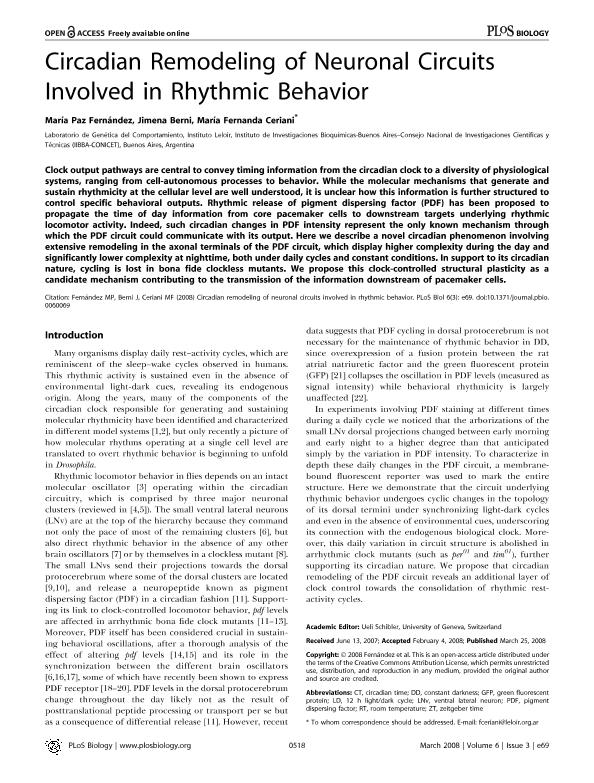Mostrar el registro sencillo del ítem
dc.contributor.author
Fernandez, Maria de la Paz

dc.contributor.author
Berni, Jimena

dc.contributor.author
Ceriani, Maria Fernanda

dc.date.available
2017-11-30T19:07:39Z
dc.date.issued
2008-03
dc.identifier.citation
Fernandez, Maria de la Paz; Berni, Jimena; Ceriani, Maria Fernanda; Circadian remodeling of neuronal circuits involved in rhythmic behavior; Public Library of Science; Plos Biology; 6; 3; 3-2008; 518-524
dc.identifier.issn
1544-9173
dc.identifier.uri
http://hdl.handle.net/11336/29377
dc.description.abstract
Clock output pathways are central to convey timing information from the circadian clock to a diversity of physiological systems, ranging from cell-autonomous processes to behavior. While the molecular mechanisms that generate and sustain rhythmicity at the cellular level are well understood, it is unclear how this information is further structured to control specific behavioral outputs. Rhythmic release of pigment dispersing factor (PDF) has been proposed to propagate the time of day information from core pacemaker cells to downstream targets underlying rhythmic locomotor activity. Indeed, such circadian changes in PDF intensity represent the only known mechanism through which the PDF circuit could communicate with its output. Here we describe a novel circadian phenomenon involving extensive remodeling in the axonal terminals of the PDF circuit, which display higher complexity during the day and significantly lower complexity at nighttime, both under daily cycles and constant conditions. In support to its circadian nature, cycling is lost in bona fide clockless mutants. We propose this clock-controlled structural plasticity as a candidate mechanism contributing to the transmission of the information downstream of pacemaker cells
dc.format
application/pdf
dc.language.iso
eng
dc.publisher
Public Library of Science

dc.rights
info:eu-repo/semantics/openAccess
dc.rights.uri
https://creativecommons.org/licenses/by-nc-sa/2.5/ar/
dc.subject
Circadian Rhythm
dc.subject
Neuronal Circuits
dc.subject
Rhythmic Behavior
dc.subject.classification
Otras Ciencias Biológicas

dc.subject.classification
Ciencias Biológicas

dc.subject.classification
CIENCIAS NATURALES Y EXACTAS

dc.title
Circadian remodeling of neuronal circuits involved in rhythmic behavior
dc.type
info:eu-repo/semantics/article
dc.type
info:ar-repo/semantics/artículo
dc.type
info:eu-repo/semantics/publishedVersion
dc.date.updated
2017-11-24T14:40:04Z
dc.identifier.eissn
1545-7885
dc.journal.volume
6
dc.journal.number
3
dc.journal.pagination
518-524
dc.journal.pais
Estados Unidos

dc.journal.ciudad
San Francisco
dc.description.fil
Fil: Fernandez, Maria de la Paz. Consejo Nacional de Investigaciones Científicas y Técnicas. Oficina de Coordinación Administrativa Parque Centenario. Instituto de Investigaciones Bioquímicas de Buenos Aires. Fundación Instituto Leloir. Instituto de Investigaciones Bioquímicas de Buenos Aires; Argentina
dc.description.fil
Fil: Berni, Jimena. Consejo Nacional de Investigaciones Científicas y Técnicas. Oficina de Coordinación Administrativa Parque Centenario. Instituto de Investigaciones Bioquímicas de Buenos Aires. Fundación Instituto Leloir. Instituto de Investigaciones Bioquímicas de Buenos Aires; Argentina
dc.description.fil
Fil: Ceriani, Maria Fernanda. Consejo Nacional de Investigaciones Científicas y Técnicas. Oficina de Coordinación Administrativa Parque Centenario. Instituto de Investigaciones Bioquímicas de Buenos Aires. Fundación Instituto Leloir. Instituto de Investigaciones Bioquímicas de Buenos Aires; Argentina
dc.journal.title
Plos Biology

dc.relation.alternativeid
info:eu-repo/semantics/altIdentifier/url/http://journals.plos.org/plosbiology/article?id=10.1371/journal.pbio.0060069
dc.relation.alternativeid
info:eu-repo/semantics/altIdentifier/doi/http://dx.plos.org/10.1371/journal.pbio.0060069
Archivos asociados
